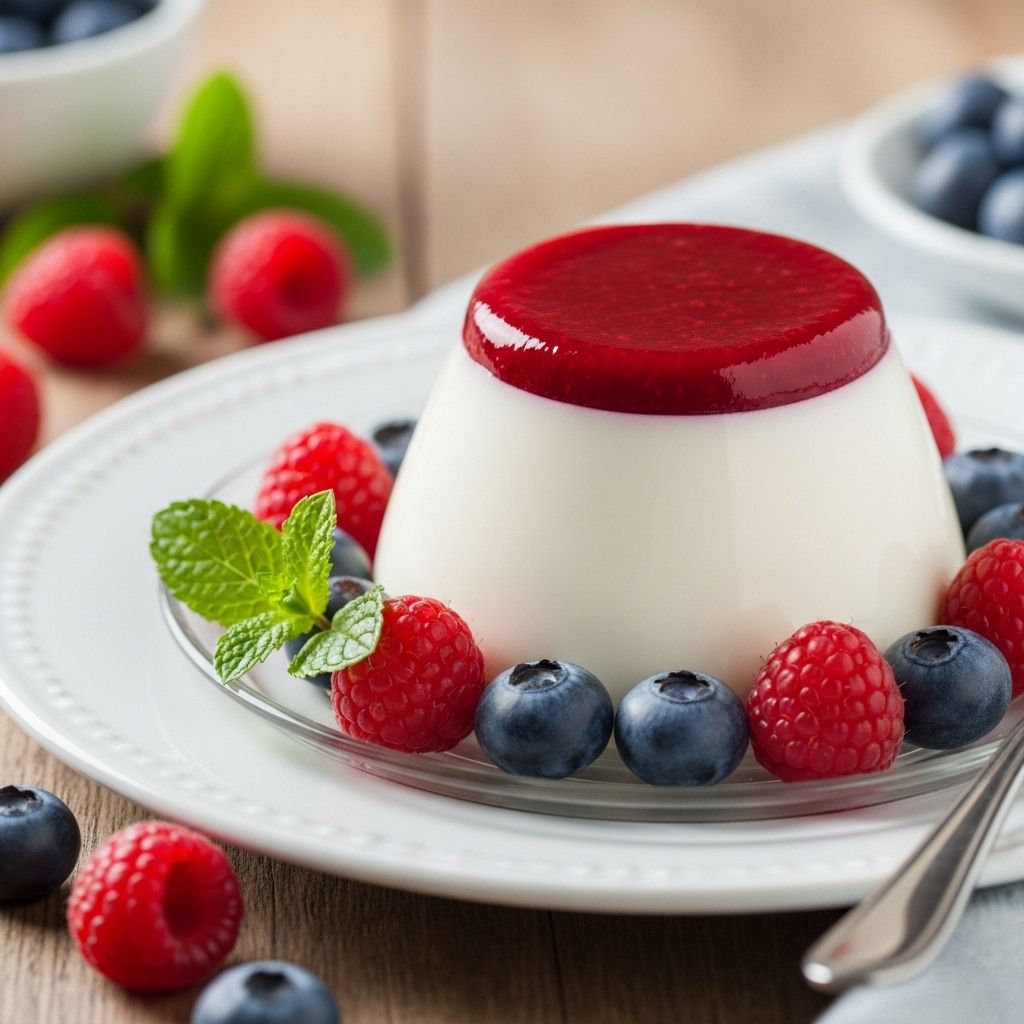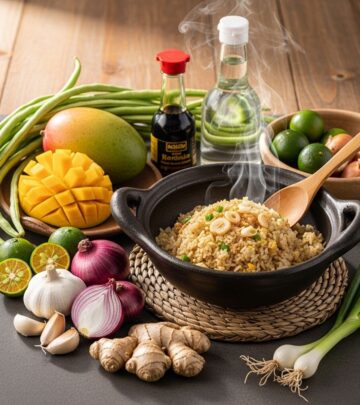Panna Cotta Recipe: 7 Foolproof Steps For Silky Italian Dessert
Silky, elegant, and easy—learn how to master authentic panna cotta and customize it for every occasion.

Image: HearthJunction Design Team
Classic Panna Cotta Recipe: The Quintessential Italian Dessert
Panna cotta, the legendary Italian dessert whose name means “cooked cream,” is beloved for its silky-smooth texture, elegant simplicity, and endless potential for customization. Whether you’re seeking a make-ahead dinner party dessert or a sweet treat to savor any night of the week, panna cotta is a timeless choice. In this thorough guide, you’ll discover everything you need to know to create flawless panna cotta—from ingredients and method to serving suggestions and expert tips.
What Is Panna Cotta?
Panna cotta is a classic Italian custard dessert that is set with gelatin rather than eggs. This makes it luxuriously creamy yet delicate, with a melt-in-your-mouth texture. Traditionally served chilled and unmolded onto a plate, panna cotta can be simply flavored with vanilla or transformed with various infusions, sauces, and toppings.
Ingredients for Classic Panna Cotta
- ⅓ cup skim milk – Used for blooming the gelatin.
- 1 (0.25 ounce) envelope unflavored gelatin – Essential for setting the custard.
- 2 ½ cups heavy cream – Provides the signature richness and creamy mouthfeel.
- ½ cup white sugar – Sweetens the base.
- 1 ½ teaspoons vanilla extract – For classic flavor; feel free to use real vanilla bean for a more aromatic variety.
These ingredients yield six generous servings of panna cotta, but the recipe can be easily doubled or halved as needed.
Step-by-Step Directions
- Bloom the Gelatin: Pour ⅓ cup of cold skim milk into a small bowl. Sprinkle the gelatin powder evenly over the top and stir gently to combine. Let it sit for 5–10 minutes, allowing the gelatin to absorb the milk and “bloom.” This step is crucial for a smooth and lump-free panna cotta.
- Heat the Cream and Sugar: In a saucepan, combine 2 ½ cups heavy cream and ½ cup sugar. Set the pan over medium heat. Stir frequently and bring the mixture just to a gentle boil—watch closely, as cream can quickly bubble up.
- Add the Gelatin Mixture: Once the cream mixture reaches a boil, immediately remove it from the heat and stir in the bloomed gelatin. Continue stirring until the gelatin is completely dissolved (about 1 minute).
- Incorporate the Vanilla: Stir in 1 ½ teaspoons vanilla extract (or scrape in the seeds of a vanilla bean, if using). Mix thoroughly.
- Pour and Cool: Divide the warm cream mixture evenly among 6 ramekins or small serving cups. Allow the mixture to cool, uncovered, at room temperature for about 20 minutes, until no longer warm.
- Chill to Set: Once cooled, cover each ramekin with plastic wrap. Refrigerate for at least 4 hours, preferably overnight, until the panna cotta is firm and jiggly.
- Unmold (Optional) and Serve: To unmold, run a thin knife around the edge of each ramekin; briefly dip the bottom in hot water, then invert onto a plate. Garnish as desired and serve chilled.
Tips for Perfect Panna Cotta
- Careful with Boiling: Only bring the cream to a gentle boil, then remove from heat immediately. Overheating can alter the texture.
- Bloom the Gelatin Fully: Proper blooming prevents lumps and ensures even setting.
- Customize Consistency: Use heavy cream for maximum richness. You can substitute half-and-half for a lighter version but may need more gelatin for proper setting.
- Flavoring Ideas: Vanilla is traditional, but you can infuse the cream with citrus peels, coffee, spices, or herbs before straining and setting.
- Texture Troubleshooting: Too much gelatin makes a rubbery custard; too little results in a loose set. Stick to the recommended proportions.
Variations and Customizations
The basic panna cotta is highly versatile and can be adapted with countless variations:
- Fruit Compotes and Sauces: Pair with fresh berries, strawberry coulis, or passionfruit syrup for a bright, tangy contrast.
- Chocolate: Add melted dark, milk, or white chocolate to the cream for a decadent twist.
- Infusions: Simmer the cream with a split vanilla bean, citrus zest, coffee beans, or spices (like cardamom or cinnamon), then strain before adding gelatin.
- Dairy Alternatives: Substitute coconut cream or almond milk for a non-dairy version—just note that the texture may differ and require recipe adjustments.
- Alcohol: A splash of liqueur (like amaretto or limoncello) can add complexity.
- Layered Panna Cotta: Alternate flavors in layers by chilling each layer before pouring the next.
Serving and Presentation Suggestions
Panna cotta is traditionally unmolded onto small plates, but it can also be served directly in elegant glasses or ramekins. Consider these serving ideas:
- With Fresh Berries: Top with ripe strawberries, raspberries, or blueberries and a mint sprig.
- With Fruit Sauce: Drizzle with berry coulis, mango puree, or caramel sauce.
- With Chocolate: Serve with a dark chocolate sauce or shavings for a sophisticated look.
- Citrus Zest: Garnish with finely grated lemon or orange zest for brightness.
- Nut Brittle: Add crunch with pistachio, almond, or hazelnut brittle.
Make-Ahead and Storage Information
- Ideal for Entertaining: Panna cotta must be made ahead, making it perfect for dinner parties. Prepare it up to 2 days in advance and keep tightly covered in the refrigerator.
- Storage: Store panna cotta in the refrigerator for up to 3 days. Do not freeze, as freezing changes the texture.
- Unmolding Tips: Briefly dip ramekins in hot water and run a knife around the edge to help unmold. If serving in glasses, garnish and serve as-is.
Panna Cotta FAQ
What is the origin of panna cotta?
Panna cotta hails from the northern Italian region of Piedmont, where it has long been a favorite dessert for its simplicity and adaptability. Its name literally means “cooked cream.”
Can I use half-and-half instead of heavy cream?
Yes, you can use half-and-half for a lighter version, but the richness and mouthfeel will be diminished. You may need to slightly increase the gelatin to help it set as firmly as with heavy cream.
Why did my panna cotta come out rubbery or too loose?
Rubbery panna cotta usually means too much gelatin was used; a loose or unset custard indicates not enough gelatin or improper blooming. Stick to the correct proportions and follow the steps for blooming gelatin for best results.
Is panna cotta gluten-free?
Classic panna cotta, prepared from cream, sugar, gelatin, and vanilla, is naturally gluten-free. However, always check that your gelatin brand is certified gluten-free and that any flavorings or toppings used contain no hidden gluten.
Can panna cotta be made dairy-free or vegan?
Yes, you can substitute plant-based creams and use agar-agar as a setting agent, though the texture will be slightly different from traditional panna cotta. Coconut cream and almond milk are popular bases for vegan versions.
How long does panna cotta take to set?
Panna cotta typically takes at least 4 hours to set in the refrigerator, but overnight chilling is ideal for the perfect texture.
What can I do with leftovers?
Leftover panna cotta can be enjoyed as-is, layered into trifles with cake and fruit, or mixed into milkshakes for an extra creamy treat.
Nutrition Information (Per Serving, Approximate)
| Nutrient | Amount |
|---|---|
| Calories | 340 kcal |
| Fat | 28 g |
| Carbohydrates | 19 g |
| Protein | 3 g |
| Sugar | 17 g |
| Cholesterol | 95 mg |
| Sodium | 35 mg |
These values are estimates and can vary based on substitutions and toppings used.
Expert Tips for Customizing Panna Cotta
- For a More Intense Vanilla Flavor: Infuse the cream with a split vanilla bean instead of extract. Scrape the seeds into the cream, simmer with the pod, then remove before adding gelatin.
- For a Softer Set: Slightly reduce the gelatin for an even silkier texture, but be aware it may be harder to unmold.
- Creative Molds: Use silicone molds or specialty shapes for a dramatic presentation.
- Layer with Fruit Gelée: Prepare a fruit gelée (using fruit puree and gelatin) and layer it atop or beneath the panna cotta for a striking visual and flavor combo.
Conclusion: The Versatility and Allure of Panna Cotta
Panna cotta’s effortless beauty lies in its simplicity, adaptability, and melt-in-your-mouth texture. With just a handful of ingredients and straightforward technique, it transforms into a show-stopping dessert suited for any occasion. Whether you serve it plain and classic, topped with fruit, or as the base for creative twists, panna cotta is a timeless recipe every dessert lover should master. Experiment with flavors, toppings, and molds to make each version uniquely your own and enjoy the pleasures of Italian cuisine at home.
References
- https://www.allrecipes.com/recipe/72567/panna-cotta/
- https://www.allrecipes.com/article/how-to-make-panna-cotta/
- https://www.allrecipes.com/recipe/150221/panna-cotta-with-fresh-strawberry-sauce/
- https://food52.com/hotline/20995-can-i-use-whipping-cream-or-half-and-half-for-making-panna-cotta
- https://www.youtube.com/watch?v=qNCamYIFllk
Read full bio of Shinta












